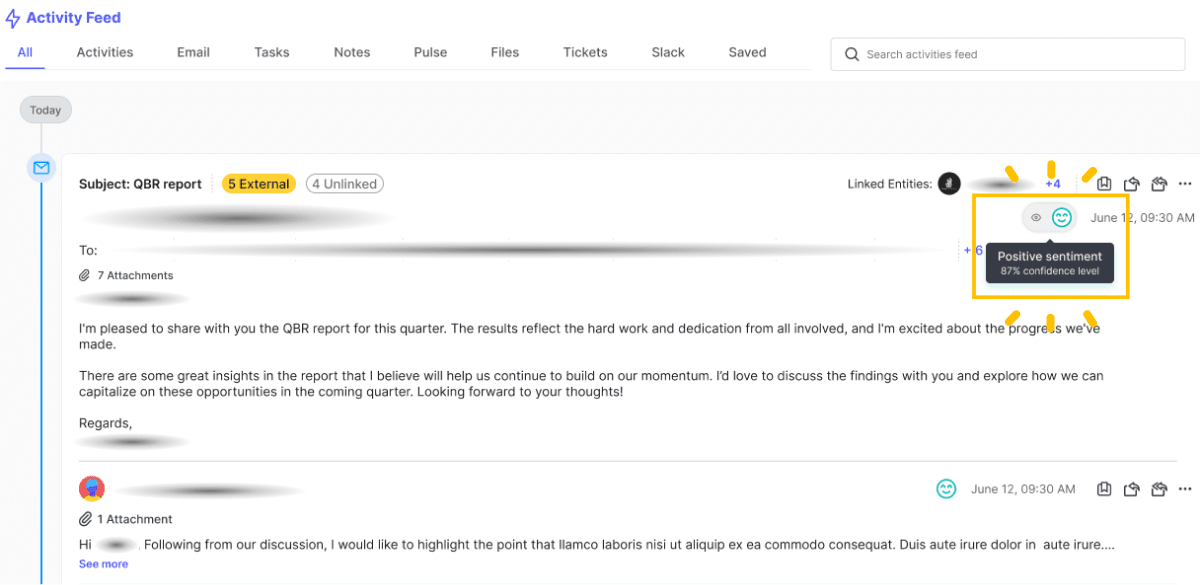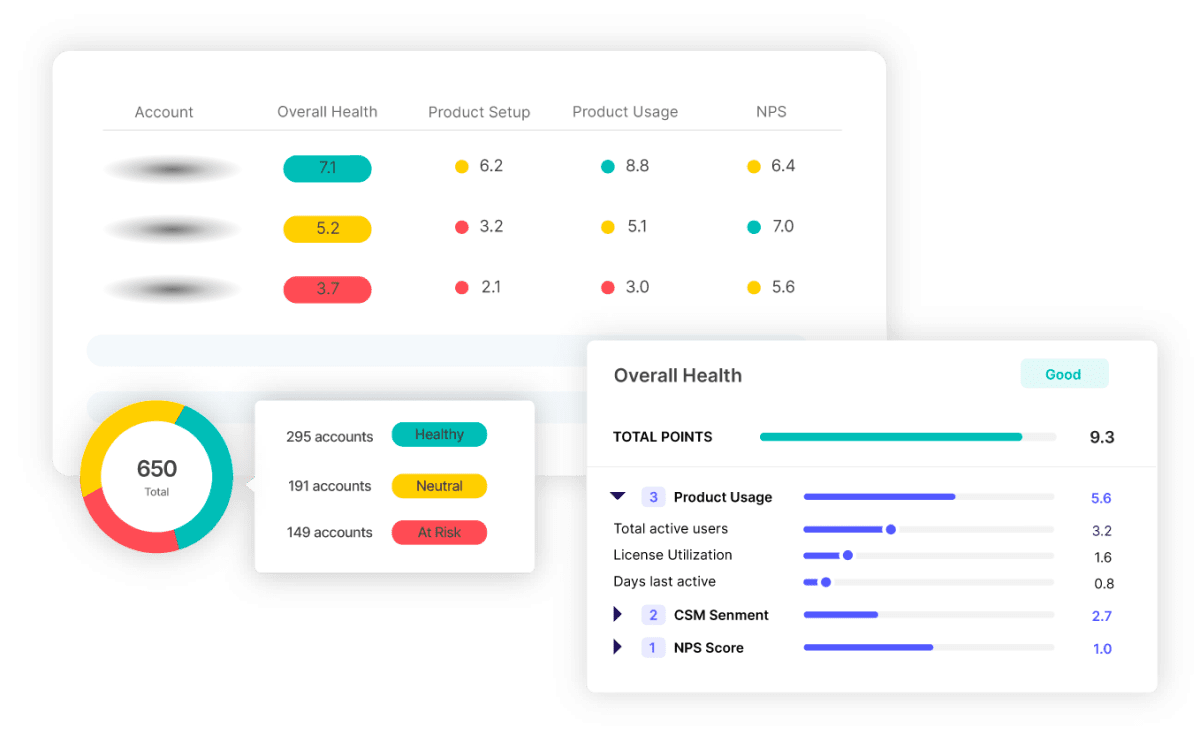Using AI to Identify Trends in Sentiment in Customer Success
Have you ever felt overwhelmed by the sheer volume of customer feedback that comes your way? As a CSM with years of experience under my belt, I know that understanding customer sentiment is key to keeping our clients happy and engaged. But let's be honest – when that feedback is scattered across emails, support tickets, surveys, and other channels, it can feel like an uphill battle to make sense of it all.
In my time working with customers, I've found that manually sifting through this feedback to identify trends is not just time-consuming but also leaves room for error. No matter how careful we are, there’s always the risk of missing something important, which can lead to missed opportunities for improvement.
That's where AI comes into play. Instead of spending hours trying to piece together insights, imagine having a tool that does the heavy lifting for you. AI can analyze qualitative data at scale, flag sentiment, and even suggest actionable insights – all in a fraction of the time it would take us to do it manually. With AI, we can be more proactive in addressing customer needs, ensuring that no valuable piece of feedback slips through the cracks.
If you're like me and have felt the strain of managing customer sentiment manually, it's worth considering how AI could streamline this process and give you more time to focus on what really matters – building strong, lasting customer relationships.
The Role of Sentiment Analysis in Customer Success
As Customer Success Managers, our primary goal is to keep customers satisfied and engaged. But how do we really know how our customers feel? Sure, we can look at the numbers – renewal rates, usage stats, and the like – but those metrics only tell part of the story. The real insight comes from understanding the emotions behind the data, which is where sentiment analysis plays a crucial role.
Sentiment analysis allows us to tap into the emotional undercurrents of our customer interactions. By analyzing the tone and context of their feedback – whether it’s through emails, support tickets, or surveys – we can gauge their satisfaction levels, identify any pain points, and even spot potential churn risks before they become bigger issues. This kind of insight is invaluable because it helps us prioritize the issues that matter most to our customers, ultimately leading to improved retention and stronger loyalty.
For example, if a significant portion of your customers are expressing frustration about a particular feature, sentiment analysis helps you catch that trend early. You can then prioritize this issue and work towards a solution before it affects more users. By understanding what’s driving your customers’ sentiments, you’re better equipped to address their concerns proactively, which strengthens the relationship and shows that you’re truly listening.
But as useful as sentiment analysis is, it’s not without its challenges – especially when done the traditional way. Manually parsing through feedback and trying to extract meaningful insights can be a tedious and error-prone process. In the next section, I’ll dive into some of the challenges we face with traditional sentiment analysis methods and why it might be time to explore new approaches.
Challenges in Traditional Sentiment Analysis
When it comes to traditional sentiment analysis, I’ve often found myself spending hours sifting through emails, support tickets, and survey responses, trying to make sense of how our customers truly feel. It’s a crucial task, but let’s be honest – it’s also incredibly time-consuming and inconsistent.
As much as we try to be objective, human interpretation can vary, leading to different conclusions depending on who’s doing the analysis or even what kind of day they’re having.
And when you’re dealing with data from multiple sources – emails, social media, surveys – the challenge only grows. Maintaining accuracy and consistency across such a vast amount of information is nearly impossible without some form of automation.
This is where AI comes into play as a real game-changer. AI-powered sentiment analysis tools can handle large volumes of data at a speed and scale that just isn’t feasible manually. These tools don’t just process the data – they provide consistent and unbiased insights that we can rely on.
For instance, AI can cluster sentiment by specific topics, customer segments, or even channels, helping us pinpoint exactly where issues are arising and why. This level of granularity allows us to be much more effective in our roles as CSMs because we can address the most pressing concerns quickly and with confidence.
Tools like Velaris take this a step further by integrating AI-powered sentiment analysis directly into the customer success workflow. With Velaris, we don’t have to dig through endless emails or messages to get a sense of customer sentiment – AI flags it for us, making it easier to spot and act on feedback.
The ability to cluster and evaluate sentiment by topic, customer segment, channel, or feature means we can quickly identify patterns and address issues before they escalate. This not only saves us time, but also improves the overall customer experience by allowing us to be more proactive in our approach.
Next, I’ll explore how AI doesn’t just stop at sentiment analysis – it also identifies trends over time, helping us anticipate future challenges and opportunities. Understanding these trends can give us a strategic advantage in shaping our customer success strategies.
How AI Can Identify Trends in Sentiment
When managing customer relationships, one of the biggest challenges is staying ahead of the curve. We often find ourselves reacting to issues as they arise rather than anticipating them. I’ve been in situations where a problem escalated simply because we didn’t see the warning signs early enough. This is where AI’s ability to detect patterns in sentiment can make a real difference.
AI doesn’t just analyze feedback in isolation; it looks at historical data to spot trends in customer sentiment over time. This capability allows us, as CSMs, to identify potential issues before they become critical.
By understanding these patterns, we can take proactive steps to address emerging concerns, ultimately improving the customer experience and reducing churn. It’s like having an early warning system that helps us stay one step ahead.
Real-time monitoring is another game-changer. AI tools can track customer sentiment as it evolves, giving us the ability to respond immediately. Imagine being able to see a shift in customer emotions right after a major product update or a support interaction.
This real-time feedback loop enables us to take action before a small issue turns into a big problem. It’s about being responsive and attentive to our customers' needs in the moment, which can make all the difference in maintaining strong, positive relationships.
Velaris is actually working on an AI-driven trend analysis tool that can analyze various customer interactions – whether it’s emails, support tickets, call transcripts, or even notes – to identify trends in sentiment.
The AI copilot doesn’t just highlight these trends; it also suggests actionable next steps, making our job a little easier and a lot more effective.
Additionally, Velaris allows us to monitor a customized customer health score, giving us a holistic view of our customers' overall sentiment and potential risks. This comprehensive approach helps us prioritize our efforts where they’re needed most.
As we continue to leverage AI for trend identification, it’s also important to explore how automation can further streamline our customer success processes. By automating routine tasks, we can focus more on strategic initiatives that drive long-term success.
Automating Customer Success Processes with AI
As CSMs, we know that time is one of our most valuable resources. We juggle a variety of tasks, from managing customer relationships to analyzing feedback and addressing issues as they arise. But the reality is, some of these tasks can be incredibly time-consuming, especially when they’re routine or repetitive. This is where automation, powered by AI, comes into play.
Automating routine tasks can significantly streamline our workflows. For instance, AI can handle things like ticket categorization, automatic email responses, and even the initial analysis of customer feedback.
By taking these tasks off our plates, we’re freed up to focus on more strategic initiatives – like digging into negative sentiment trends or identifying opportunities for upsell. It’s about working smarter, not harder, and using our time where it truly matters.
Another benefit of automation is the consistency it brings to our processes. When AI handles repetitive tasks, it ensures that every customer interaction is managed in a standardized way.
This consistency is crucial for maintaining a positive and seamless customer experience across all touchpoints. We’ve all seen how even small inconsistencies can lead to customer frustration. By automating certain processes, we can reduce the risk of human error and ensure that each interaction meets the same high standard.
Velaris offers powerful tools to help with this automation. The drag-and-drop automation builder is a game-changer. It allows us to set up automated processes with ease, such as sending follow-up emails based on sentiment analysis results. This feature not only saves time but also ensures that our communications are timely and relevant.
As we continue to embrace automation, we should also be mindful of how it can complement our efforts in other areas, such as trend identification and real-time sentiment monitoring. By integrating these AI-driven tools into our daily workflows, we can become more proactive and efficient in our roles, ultimately leading to better outcomes for our customers.
Conclusion
AI has made it easier for us to get a clear picture of customer sentiment, helping us identify trends, automate routine tasks, and ultimately boost customer satisfaction. By leveraging AI, we can be more proactive in addressing customer needs and catching potential issues before they turn into bigger problems like churn.
If you haven’t yet explored AI-powered customer success management tools, I’d encourage you to take a closer look at how they can enhance your ability to understand and act on customer sentiment. Tools like Velaris can make a significant difference in your day-to-day operations, making it easier to stay ahead of customer sentiment trends and drive long-term success.
Have any questions or thoughts on how AI is changing our field? Feel free to drop a comment – I’m always open to a good conversation!



